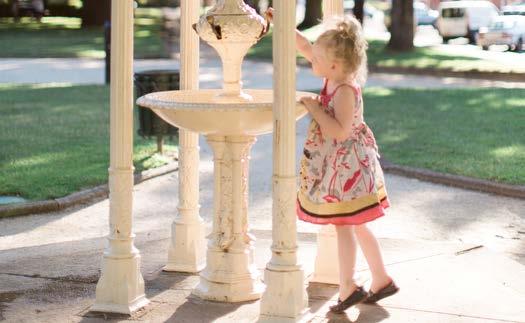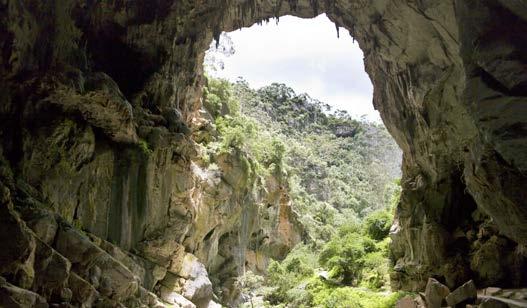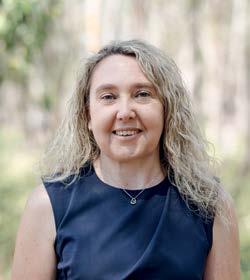CONSERVE
The Gondwana Rainforest of Australia Formerly known as the Central Eastern Rainforest Reserves, the Gondwana Rainforests of Australia are older than the Amazon rainforests, and form the most extensive area of subtropical rainforest in the world. They are a UNESCO World Heritage Site.
Heritage Lost and Saved in the Fires
The area includes 50 reserves, covering 3,665 square kilometres, and is sited around the New South Wales-Queensland border. The Gondwana Rainforests are so called because the fossil record indicates that when Gondwana existed it was covered by rainforests containing the same kinds of species living today. The number of visitors to the reserve is about 2 million per year. Fifty per cent of the Gondwana Rainforests of Australia were burnt by the bushfires in New South Wales and Queensland.
BY GRAHAM QUINT, DIRECTOR, CONSERVATION
Bushfires that swept through New South Wales from September 2019 to early February 2020 devastated the landscape, razed homes and towns to the ground, incinerated wildlife and claimed the lives of 25 people. While National Trust properties under threat in the Blue Mountains, the Southern Highlands and Tenterfield were saved, irreplaceable heritage across the state has been consumed by these fires. It will be months before the National Trust can determine how many buildings of historic significance were damaged or lost. Councils and government authorities will need to concentrate their efforts in coming months on assisting people impacted by the bushfires and dealing with the continuing fire threat. The assessment of impact on natural heritage has only just commenced. Places that have been threatened, damaged or destroyed by the fires include World Heritage Areas, National Parks, Nature Reserves, State Forests, private forested lands, farming and pastoral landscapes, historic gardens and entire ecosystems and their biota. The National Trust will help to record these losses, liaising with firefighting experts, fire behaviour scientists and our expert staff and technical specialist committees. We aim to provide robust input into the proposed bushfire inquiry, to communicate our assessment with our members and ensure the community is aware of the scale and impacts of the bushfires.
Most of the rhododendrons in the Species and the Quota areas had been destroyed, as had some plantings between the developed and the native areas on the north side of the creek. Even part of the swamp was damaged, due to ignition of methane gas, which the area emits. Firefighters prevented the blaze from crossing the valley to the main developed Garden area, saving the Lodge and other buildings. The National Trust’s own property at Bargo was impacted by fire, with the loss of some buildings, but the dingoes at the property were saved from the fire (see page 5). At Cobargo, west of Bermagui, the Bega Valley Shire Local Environmental Plan 2013 Cobargo Main Street Conservation Area and four heritage-listed buildings were destroyed by a bushfire. Nine buildings were destroyed, including the former 1891 Grain Store, two c1880 two-storey weatherboard buildings, and the 1882 former Australian Joint Stock Bank. Several National Trust properties were under threat in the Blue Mountains as fire came within 500 metres of the colonial buildings at Woodford Academy, and one kilometre of Everglades House & Gardens with its Art Deco architecture and Paul Sorensen designed garden. When fire crossed the Grose River below the Norman Lindsay Gallery & Museum Faulconbridge, we placed oil paintings and illustrations in storage offsite. Greater Blue Mountains World Heritage Area
Built Heritage Information related to the impact of the bushfires on buildings of heritage significance is new and emerging gradually. The former 1890 James Barnet Kiandra Courthouse, listed on the State Heritage Register and the recipient of a 2011 National Trust Heritage Award for adaptive re-use by the NSW National Parks and Wildlife Service, was burnt despite being in open country and well away from adjoining vegetation. The National Trust is endeavouring to establish whether any of the historic buildings at Yerranderie were damaged or destroyed when the Green Wattle Creek fire passed through the area. 6
On 21 December 2019 (declared catastrophic fire condition day), The Blackheath Campbell Rhododendron Garden was severely damaged by the Grose Valley fire. While the Conifer Garden was left intact, nearly all the native bush on the north side of the valley and the service road was severely burnt.
Covering about 10,300 square kilometres, this World Heritage Area is about one-third the size of Belgium, or twice the size of Brunei, with large areas of wilderness. It has rare and different plants and animals that tell the story of Australia’s great age, showing the evolution of Australia’s unique eucalypt trees and the other plants and animals that live among them. It comprises eight protected areas in two main blocks that are separated by land set aside for transport and housing, including Jenolan Caves Karst Conservation Reserve, Blue Mountains National Park, Wollemi National Park, Yengo National Park,
National Trust (NSW)
Landscapes listed on the National Trust Register A survey of Landscape Conservation Areas listed on the National Trust Register was undertaken in December to determine the impact of the bushfires, and 17 areas had been impacted by the fires. By 21 January, several more areas had been affected.
Nattai National Park, Kanangra-Boyd National Park, Gardens of Stone National Park and Thirlmere Lakes National Park. On 26 October, a lightning bolt started a fire near a disused airstrip at Gospers Mountain in the Wollemi National Park. This became the epicentre of the biggest forest fire started from a single ignition point that Australia has ever known. By mid-January, the Gospers Mountain Fire and other major bushfires had joined, and 80 percent of the Greater Blue Mountains World Heritage Area was burnt.
Among the worst-affected areas, Wolgan Valley was totally burnt. Ninety per cent of Hastings Valley, containing large tracts of rainforest and the largest unlogged Antarctic beech forests in New South Wales, had been impacted. Half of the Ben Halls Gap Old Growth Forest Landscape Conservation Area has also been burnt. This area was one of the best remaining examples of unlogged, high nutrient, old-growth forest on the Northern Tablelands of New South Wales. About 60 percent of the Washpool Landscape Conservation Area, containing the largest remaining undisturbed rainforest in New South Wales and the largest intact coachwood rainforest in Australia, had also been severely damaged by the fires. From top The majority of the Jenolan Caves area was destroyed; ruins at Newnes in the Wolgan Valley, which was completely burnt out by the bushfires; John Hewson.
TRUST TALKS
Why is Climate Change a Hot Topic for Heritage? Keynote speaker: John Hewson AM Professor and Chair, Tax and Transfer Policy Institute, Crawford School & the Climate Change Institute, Australian National University This event was originally scheduled to take place on 2 June 2020 at NSW Parliament House, Macquarie Street, Sydney. We have postponed this event to October 2020 and will share the new date in the next edition of this magazine, on our website nationaltrust.org.au/whats-on-nsw/, via our eNews and on Facebook @nationaltrustau Tickets: Early bird prices apply until 1 August. Tickets include drinks and canapes. Book at eventbrite.com.au Enquiries: Jilly Clark, email jclark@nationaltrust.com.au
April – June 2020
COMING UP
The Value of Heritage 6 August, 5.30pm – 8pm, NSW Parliament House. To register your interest for this talk, email Jilly Clark, jclark@nationaltrust.com.au
7






